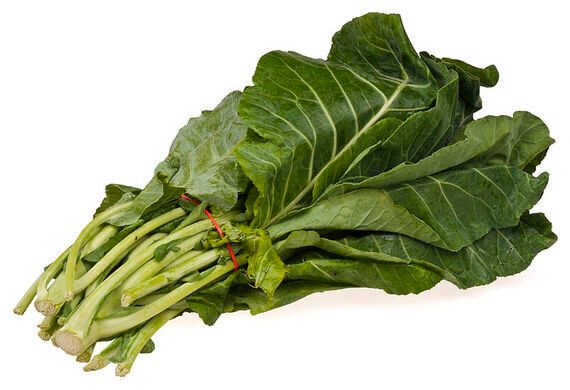- co-authored by Jill Parnell -
Kale, schmale! Of course, we are joking - we love kale - but there are a variety of delicious and nutritious leafy greens available this time of year. Often called "winter greens", these hardy cultivars are closely related to cabbage and thrive as the temperatures get cooler. Time to substitute the so-called spring greens like dandelion, watercress and delicate lettuces in favour of more robust greens!

Leafy greens are a great low-calorie source of fibre as well as vitamins and minerals like beta-carotene, vitamin C, vitamin K and calcium. If you have always avoided leafy greens because of their bitter reputation, time to give them another chance! Those bitter compounds are actually disease-fighting phytochemicals like polyphenols, flavonoids, glucosinolates and betalains. Regularly eating steamed greens may help reduce "bad" LDL cholesterol by binding bile acids in the intestine, thus inhibiting cholesterol absorption (1). Need another reason? Glucosinolates found in greens and cruciferous veggies have been linked to reduced risk of prostate, colon and bladder cancer, as well as reduced risk of breast cancer recurrence (2,3,4,5).
When shopping for greens, look for brightly coloured, crisp leaves free of blemishes or wilting. Avoid any that are heavily yellowed or have slimy edges. Smaller bunches are often more tender and less bitter. To maximize freshness when storing, wrap the stem ends in a damp paper towel, loosely bag in plastic and place in the fridge. Make sure to wash greens well before cooking to remove any sand or grit.
Here's a rundown of some of our favourite seasonal greens:
- Rapini: Also called "broccoli raab", rapini is actually more closely related to turnips, hence their slightly spicy taste. Delicious sauteed with olive oil, garlic and red chili pepper flakes. Great source of folate for women of child-bearing age.
- Kale: Loaded with vitamins, minerals and antioxidants, kale lost to broccoli in our Food Fight! based solely on higher price. We love kale in all forms, especially kale chips.
- Swiss chard: This relative of beets and spinach is much more tender and less bitter than other greens, so requires less cooking. Fantastic tossed into soup, like a hearty minestrone or in a stir-fry.
- Mustard greens: One of the more pungent Brassica greens, mustard greens benefit from braising. Very popular in India, they are a natural side for spicy curry-based dishes when cooked simply with garlic and ginger.
- Turnip greens: One of the best sources of antioxidant beta-carotene, turnip greens are also rich in calcium and potassium. A classic in the south with pork, a little bit of pancetta or bacon goes a long way.
- Collard greens: Rich in calcium, a one cup serving of cooked greens contains nearly 300 mg of calcium! That's equivalent to one glass of milk. Although slow-cooked collards are amazing, we love the quick sauté of thinly sliced collards with garlic, a common dish in Brazil.
When cooking greens, bitterness is a frequent complaint. To tone down bitterness, pair greens with spicy (garlic, chilies), creamy (pine nuts, touch of cream) or salty (bacon, feta) ingredients. Not sure where to start? Here are some great recipe ideas from Eating Well.
Lentil and Kale Salad with Creamy Cashew Dressing - serves ~ 6
While kale is certainly the most popular and buzz-worthy of the leafy greens, we love this recipe because it is a bit unexpected: raw, uncooked kale. We actually prefer tougher green curly kale vs. the more tender lacinato (aka black Tuscan or dinosaur kale) in this recipe. Use some elbow grease and massage the dressed leaves to give them a lovely, soft texture. Cathartic too (you don't have to be too gentle)!
ingredients
creamy cashew dressing
- 1 cup cashews, soaked for 2 hours and drained
- juice 1 lemon
- zest of 1 lemon
- ¼ cup water
- 1 tsp salt
- ¼ cup chopped parsley
- 2 tbsp chopped mint
salad
- 2 bunches raw curly kale, center ribs and stems removed, washed, dried
- 1 cup Puy or French lentils, rinsed and picked over
- 1 cup red cabbage, shredded
- 1 red bell pepper, diced
preparation
- Place lentils in a small saucepan with enough water to cover them by 3-4 inches (approximately 2-½ cups). Bring water to a boil, then reduce heat and let the lentils simmer for 20-25 minutes, or until the lentils are tender but not mushy. Rinse in a fine-mesh sieve and set aside to cool.
- While lentils cook, combine dressing ingredients in a food processor and blend until creamy. Season with salt and pepper to taste.
- Toughly tear kale into bite-sized pieces and place in a large mixing bowl. Take 6 tbsp of dressing, pour over kale and massage (yes, massage!) into the leaves. This should be enough dressing for the salad to be well-coated and start taking on a "wilted" texture; you don't want it soupy. Set aside.
- Add cooled lentils to kale, along with the cabbage and red pepper, and add another 2 tbsp vinaigrette. Use hands to combine. Add extra dressing as needed, and season to taste.